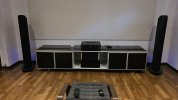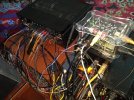
I purchased the Marataz Model 30 about 2 weeks back from HifiMart. I asked around and they gave me the best price by far. My system up until that point consisted of Golden Ear Triton 2+ speakers, Denon x3700h AVR and Chord 2Qute DAC. The Denon is a very component AVR (very clean and powerful) and good enough for even critical 2 channel listening, but I planned to upgrade over time to a dedicated stereo amp.
I tried the Cayin A88 MkII tube amp for a while as a power amp. I loved the sound, very soulful, except for the bass, I cannot stand sloppy bass. I even had the Denon A110 at home briefly - purchased from ProFX for a small fortune only to find it was an open box item, which was promptly returned. A110 had a very clean DAC and a pure and smooth sound.
Build is excellent, love the modern look. The remote is a solid block of metal. But nothing, and I mean nothing, will ever come close to the look and build of the Denon A110 if you have very seen one in person.
As soon as I plugged in the Model 30, first think that stuck me was how THICK and meaty the sound was. This is a very solid sounding amp. All of the amps I have tried up until this point were thin sounding to various degrees. Its the thing I wanted to remedy the most in my system. The Cayin was the best in that regard, both the Denon, especially the receiver were thin, almost vapor like sounding. This was a pleasant surprise, mid range and vocal were super full bodied. I am not sure it is the monstrous power of this amp or the voicing by the Marantz HDAM modules tuning that is responsible for this. The Model 30 is measured to over 170w into 8 ohms, and over 300w peak power into 4ohms, way above its 100w/8ohm, 200w/4ohm specs. Even the beefy A110 had less power. I wanted a high power amp as I plan to own Magnepans at some point. This is a Class D amp that has been reviewed to work exceptionally well with power hungry Maggies. Highs are clean and a little rolled back, but not warm sounding like a lot of Marantz products. Bass is clean and full.
The other thing that stands out is the absolutely shocking imaging this amp is capable of. It produces an absolutely rock solid center image of the singer. The imaging with that thick sound makes vocal the highlight of its presentation, shockingly real. Of course you need a good clean DAC for this since the Model 30 is a pure analogue device with no built in DAC. My GoldenEars are imaging champs and the Model 30 is the perfect companion for them. Imaging is the most important thing I look for in an amp, its only when you visualize the singer standing in front of you that the experience get emotional. I believe this stellar performance is because the Model 30 is essentially a two-in-one, since it has a Class A pre-amp with its own toroidal power built in, as well a what is practically dual mono Class D power amp modules in one chassis. So three boxes of separates, shrunk into one chassis. Its 2L + asking price is good value if you think of it this way.
What the Model 30 lacks is depth to, and within the sound stage. My Denon AVR is excellent at portraying depth. The singer is behind the wall of the room, and the instruments can be even further behind that. The Marantz brings everything to the plain of the speakers, and instruments are closer together, so less of that 3D sound, but very good 2D. Its the only thing missing in this amp. It has only been 2 week and less than 50 hours of listening so maybe that will change with time. I will report back after a few months.
So far, very happy with my purchase. Also since this is a Marantz, service should not be an issue. Thanks to HiFi mart for excellent service. Cheers.
Last edited:


